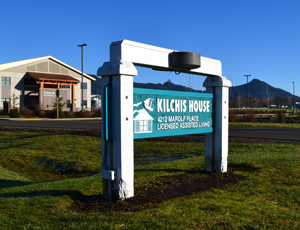By Laura Swanson
Nearly 100 people – 54 residents and 40 staff – with the ripple effect felt throughout the community with the announcement that – Nehalem Bay House and Kilchis House our locally-managed by CARE Inc., nonprofit assisted living communities are closing. Everyone knows someone, a resident or a staff member. This hits our communities deeply. Northwest Senior & Disability Services is working to assist current residents to find new places to live. “Right now, we are focused on our residents and making sure that everyone finds a comfortable, safe place to go,” said Peter Starkey, CARE director. “This entire situation has been heartbreaking for the board and staff, and we understand the devastating impact for the community. The system is broken.” This is happening in every county across Oregon facilities are fighting to remain open with other closures, and is happening across the country (see the recent article from Forbes. ) “CARE may be one of the first but we will not be the last if there is not decisive and urgent action from our state and federal government,” said Starkey. “We are on the cusp of a collapse in long term care and the healthcare system. It starts with our poor, our elderly, and in our rural communities.”
The funding has simply run out. When the initial report went out on Monday December 13, 2021 https://www.tillamookcountypioneer.net/care-inc-announces-closure-of-assisted-living-communities-nehalem-bay-house-and-kilchis-house-after-25-years-of-providing-care-in-tillamook-county/ it was met with stunned disbelief – and how could this happen? Why didn’t they do something? Ask the community to help … the reality is that the structure for assisted living reimbursements for Medicaid or Medicare simply no longer covers the costs associated with that care. And that has been the reality for Nehalem Bay House and Kilchis House for nearly the entire time of its operation (25 years). “We’ve always been right on the edge,” said Tillamook County Commissioner Erin Skaar, formerly the director of CARE, the nonprofit organization that operates the Houses. “And found ways to supplement with more private pay residents, but we were not going to ever turn any one away, when someone needed assisted living we did our best to help them.”
The pandemic brought the breaking point with staffing shortages, relying on much more expensive temporary staffing and reserves were exhausted. A prevalent question “Why didn’t they do anything?” The CARE Board and staff have been looking for solutions, options, ideas to address the current situation since early 2020.
During a press conference and subsequent community meetings, Peter Starkey, CARE director, said, “CARE has been discussing the budget shortfalls of Medicaid and state/federal funding since April, when we published it in our newsletter, and advocated during the budget development for increases to Medicaid rates. When CARE began taking from its reserves we reached out to local elected officials, state agencies, and lenders for help. Starting in August I began speaking at community meetings, the radio, and community partners about the possibility of closure.”
He continued, “The board retained a financial consultant in November to do a deep analysis of CARE’s cash flow and financial management. The hiring of this consultant was with the intent of finding a way to continue operations. After a careful review of the cash flow and financial management, the consultant concluded that CARE management had done everything possible to reduce costs. The financial consultant presented the board with 10 scenarios, and none of them displayed a path to financial sustainability for the assisted living facilities. There was no option to ensure that CARE had the cash flow to operate the facilities as assisted living.”
Here’s a timeline of actions from CARE:
- December 2020: CARE Inc. first identified a staffing issue in instituted a $250 hiring bonus.
- April 2021: CARE Inc increased hiring bonus to $500 and offered a referral bonus to current staff.
- June 2021: CARE Inc retained Voorhies and Associates (Vanda Health) as consultants
- June 2021: CARE Inc. Increased starting wages to $15/hour for caregivers and $17/hour for medtechs
- June/July 2021: Nehalem Bay House and Kilchis House began relying heavily on agency staff
- July 2021: CARE Inc. decreased controllable expenses
- July 2021: Kilchis House reserves exhausted, began borrowing from CARE Inc reserves
- September 2021: Nehalem Bay House reserves exhausted, began borrowing from CARE Inc reserves
- November 2021: The CARE Inc Board of directors retained a financial consultant to analyze current cash flow and cash left to sustain.
CARE began pulling heavily from reserves in July, when Kilchis House ran out of personal savings. Nehalem Bay House ran out of money shortly afterwards. THey have used about $700,000 of CARE reserves supporting the houses since June and the remaining $300,000 will be depleted by the end of February. CARE held about $1 million in reserves. CARE has been pulling from these reserve funds. Money was not diverted from other CARE programs.
“Why didn’t they ask the community for help?” According to Starkey, “The community already does so much to support CARE programs, it isn’t sustainable to ask the community to fundraise over $1 million per year to subsidize the Houses. We so appreciate the community wanting to do something. There simply is not a sustainable path forward with the current reimbursement systems and staffing shortages. We did everything in our power to look for a way to make it work, there isn’t one at this time.”
The community has reached out to support the Houses, staff and residents, from Rebecca Jones, “As a prior case manager at Aging and People with disabilities, I wanted to highlight the article’s reference to low state aid/assistance. The state pays a very low rate to facilities when a person is on Medicaid. The cost to care for someone is so much more than what the state allows. As a previous CNA I felt the pain both physically and financially of not being valued. This closure is multifaceted and roots in our lack of respecting our elders in this society and people experiencing poverty. It’s not about people not wanting to go to work. There’s always been a hard time finding workers because this work is hard. I think we can forget that, until we as a whole, demand better care for the people that have served us and paid into social security and led our nation for their many years than these issues will recur over and over. Don’t blame CARE. Don’t blame “lazy” people. Take action by prioritizing our seniors and disabled people whether you want to politically by calling the state or personally by helping those immediately in front of you. Be a part of the solution, not a hollow complaint that only escalates and divides and does nothing.”
Our elected officials including Commissioner Skaar and the coastal caucus, particularly Senator Betsy Johnson have all been advocating for the facilities. The legislature did pass an increase to Medicaid reimbursement, which began in October. However, this increase does not cover the 238% in increased personnel costs the Houses have experienced.
What can be done that might help ensure that this doesn’t happen in other places? Here are some suggestions from Peter Starkey:
- A stimulus program to reimburse long term care facilities for expenses incurred due to the pandemic and staffing.
- A dramatic (!) increase in Medicaid reimbursement that allows for facilities like CARE to offer competitive wages and benefits.
- Regulation of medical staffing agencies that have driven up prices to take advantage of the pandemic for financial gain
CARE Social Services will continue to offer emergency/homeless services, Healthy Families program and continue to advocate to lift up those in poverty in Tillamook County. These programs are funded separately from the assisted living facilities.
“Our first priority is the residents and getting them settled, then we’ll look at options for the buildings and we are hopeful that we can devise a plan to keep them in some kind of community-benefit use,” said Starkey. Watch for additional community meetings and conversations with CARE. “We are completely transparent about this process and are grieving along with everyone else over this situation,” added Starkey. “And especially during the holiday season.”
There is never a good time to close a treasured community like the Houses, but CARE has done everything possible to find a sustainable solution. There simply is no other option at this time but to close the assisted living communities.
Patty Rinehart sent the Pioneer a note with some great ideas to lift up those at Nehalem Bay House and Kilchis House during this holiday season – https://www.tillamookcountypioneer.net/gifts-holiday-cheer-for-seniors-at-nehalem-bay-house-kilchis-house/
https://www.tillamookcountypioneer.net/care-inc-announces-closure-of-assisted-living-communities-nehalem-bay-house-and-kilchis-house-after-25-years-of-providing-care-in-tillamook-county/
Here is CARE’s statement and more information about the closures – https://www.careinc.org/services-1


